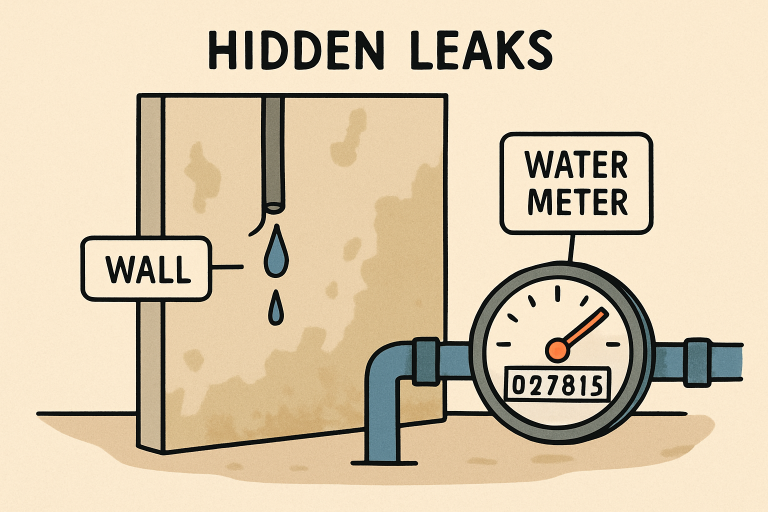Introduction
Hidden water leaks can be some of the most insidious threats to your home’s integrity and long-term value. While these leaks often go unnoticed until damage has occurred, the consequences can be dire, ranging from structural deterioration to mold outbreaks and ballooning utility bills. Many homeowners don’t realize a problem exists until water damage is extensive and costly to repair. This is why acting swiftly to identify and stop hidden leaks is crucial. Suppose you ever find yourself unable to locate a leak or need expert assistance. In that case, a water leak inspection Monroe service can step in to solve the issue before minor symptoms turn into expensive disasters. Educating yourself on both the warning signs and the most effective preventive strategies empowers you to safeguard your home and avoid unexpected expenses that can strain your budget and stress levels.
Common Signs of Hidden Water Leaks
Spotting hidden water leaks early makes all the difference in minimizing damage and repair costs. By familiarizing yourself with classic warning signs, you can act before a problem escalates:
- Unexplained Increase in Water Bills:It’s normal for water bills to fluctuate slightly, but if you notice a sharp increase without a change in your usage habits, there’s a good chance you have a hidden leak. Look for patterns by comparing several months’ bills. Sometimes, leaks are small enough to avoid immediate detection but large enough to cause measurable increases over time. Investigate promptly to avoid unnecessary costs.
- Damp or Discolored Walls and Ceilings:Water stains, bubbling wallpaper, peeling paint, and swollen drywall are warning signs of internal moisture caused by leaking pipes. Sometimes, you’ll only notice faint patches of discoloration or small, soft spots. These symptoms can appear anywhere, especially along exterior walls, under windows, and even on ceilings. Early attention to this issue can prevent major structural repairs later.
- Musty Odors:The lingering scent of mold, mildew, or rot is often most noticeable in washrooms, laundry rooms, basements, and rarely used closets. When organic materials, such as wood or drywall, become wet and remain damp, they emit a characteristic musty odor. If you notice persistent, unexplained odors, don’t dismiss them as simply the result of humidity; these are often the first clues to hidden leaks.
- Mold and Mildew Growth:Mold and mildew flourish in moist conditions created by hidden leaks. Sometimes, mold will appear in out-of-the-way spots, such as inside vanity cabinets, at the base of walls, or behind appliances. Mold is not just a cosmetic annoyance, as it can aggravate allergies, worsen respiratory conditions, and seriously impact your family’s health. If you find mold in areas that shouldn’t be damp, take action promptly.
- Low Water Pressure:A sudden drop in water pressure throughout your home, or even in just a few fixtures, should raise alarms. While a localized drop may result from a simple clog, widespread pressure issues often point to leaks or breaks somewhere in your plumbing system that are diverting flow, reducing efficiency, and potentially causing hidden damage.
How to Detect Hidden Water Leaks
Pinpointing a hidden water leak is rarely straightforward. Leaks can originate from a variety of sources and often require a combination of visual inspections and advanced tools to track them down accurately. Here are some effective methods to help you locate leaks before they spiral out of control:
1. Monitor Your Water Meter
Turn off every faucet and ensure no appliances are using water. Then, check your water meter for movement. If the meter’s indicator is still spinning, water is exiting the system somewhere. For a longer test, take a meter reading, wait a couple of hours without using any water, and see if the reading has changed. This is a clear, reliable way to determine if you have a hidden leak.
2. Conduct a Toilet Dye Test
Since toilets are frequent sources of hidden leaks, try the dye-test method. Place a few drops of food coloring into the tank and wait at least 10–15 minutes. If colored water appears in the bowl (without flushing), you may have a faulty flapper or other worn-out parts. Even slow leaks like this can waste hundreds of gallons per month, so repair or replace defective components as soon as possible.
Preventing Hidden Water Leaks
While no homeowner can prevent every mishap, proactive maintenance dramatically reduces the risk of hidden leaks and the damage they inflict. Consider these practical steps to provide consistent, long-term protection:
- Regular Inspections:Visually inspect all visible pipes, fittings, and connections in bathrooms, kitchens, utility areas, and basements for signs of corrosion, rust, or moisture. Don’t overlook under-sink plumbing, washing machine hoses, and pipes behind access panels. Early detection here is your best bet for prompt repair and cost savings.
- Maintain Proper Drainage:Ensure gutters, downspouts, and exterior drains are always clear to channel water away from your property. Clogged gutters can cause rainwater to back up toward the foundation, increasing the risk of leaks and flooding. During storms and seasonal transitions, perform an extra check to clear blockages and confirm that all drainage paths are functioning properly.
- Monitor Water Pressure:Households with excessively high water pressure are at a greater risk of pipe bursts or leaks due to the added stress on plumbing joints and seals. Install a pressure regulator if necessary and monitor your home’s levels to ensure they remain below 80 psi. This simple device can prolong the life of your entire system.




